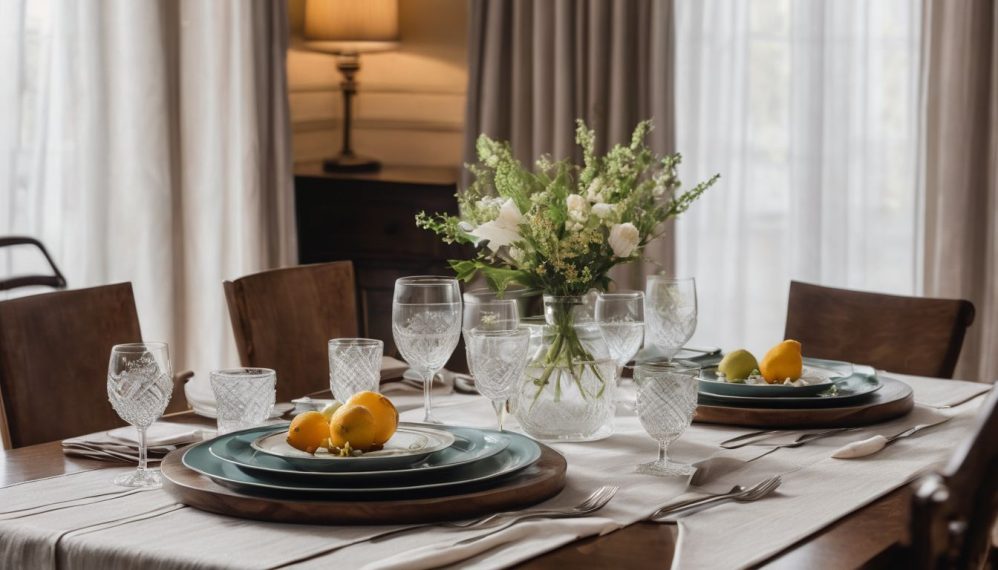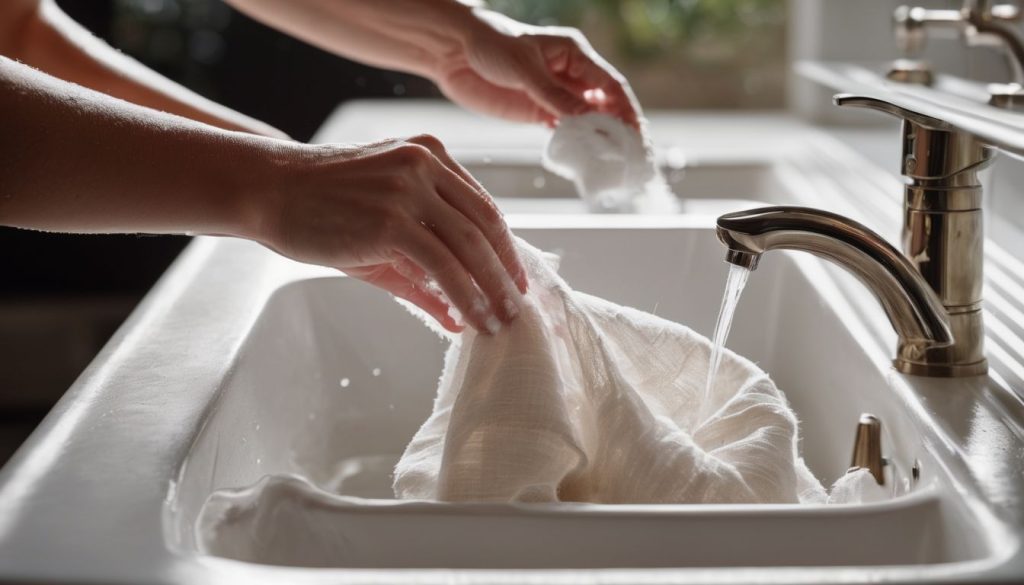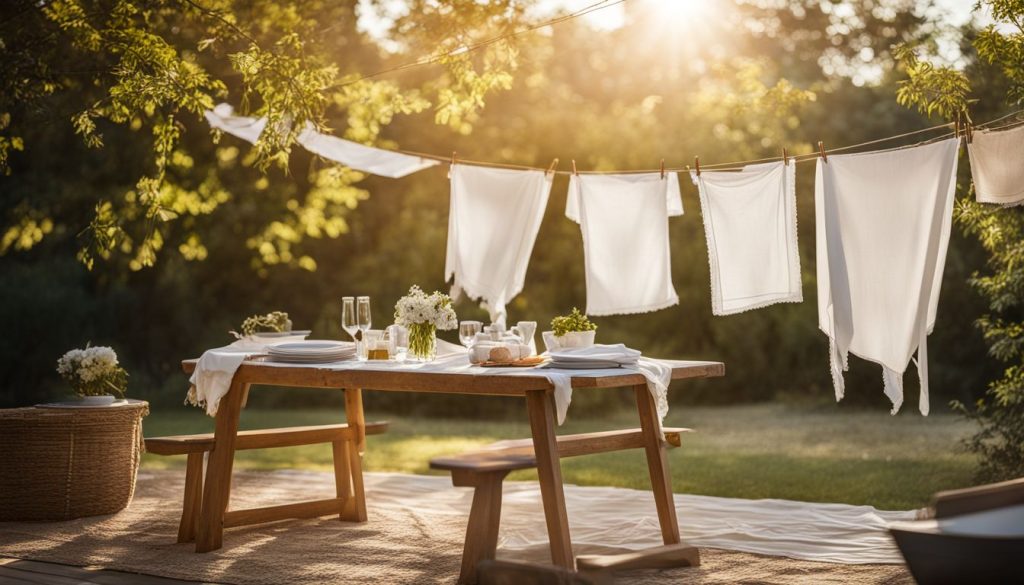
Stained or dingy table linens can be an embarrassing eyesore at family dinners or special events. Proper care of these versatile home essentials often gets overlooked, but it’s vital for their longevity and appearance. This blog post is a step-by-step guide on how to clean tables lines, tablecloths, napkins, and place mats spotless and fresh-looking using various techniques tailored to your linen type. Ready? Let’s make those stains disappear!
Key Takeaways
- Different types of table linens require specific cleaning methods. For cotton and cotton blends, machine washing on the lowest temperature with regular laundry detergent is typically sufficient.
- Linen fabric requires more delicate care and can be washed by hand or in a gentle cycle with mild detergent. Stains should be treated promptly using hydrogen peroxide or soaking them in a bucket before laundering.
- To wash table linens effectively, use the washing machine on the gentle cycle with regular laundry detergent. Set the appropriate temperature, select the correct cycle, and consider adding vinegar or baking soda for stubborn stains.
- Proper storage is essential to maintain the freshness and quality of your table linens. Fold them neatly, iron before storing to prevent creases from setting in, and store them in a cool, dry place away from direct sunlight.
Choosing the Right Cleaning Method based on Linen Type
Different types of table linens require specific cleaning methods to ensure they remain spotless and fresh-looking. Let’s explore the optimal cleaning methods for cotton and cotton blends as well as linen fabrics:
Cotton and Cotton Blends:
Cotton and cotton blend fabrics are popular choices for table linens due to their soft texture, durability, and high absorbency. Maintaining these materials is relatively straightforward:
- Washing: Machine washing is typically sufficient for cotton and cotton blends. Use the normal cycle with regular laundry detergent.
- Stain Removal: Address stains promptly. Pre-treat stains with a stain remover, and consider soaking them if necessary before laundering.
- Ironing: The advantage of cotton is that it’s easier to iron. This makes it simpler to keep your napkins and placemats smooth and fresh-looking.
It’s essential to follow these guidelines diligently to preserve the longevity of your cotton and cotton blend table linens.
Linen:
Linen tablecloths and napkins add an elegant touch to any dining setting. However, they require more delicate care and attention:
- Washing: Linen can withstand higher thermal pressure, allowing for washing at temperatures up to 90 degrees for whites and natural colors. Machine washing is permitted for linen napkins and tablecloths. Opt for a gentle cycle with mild detergent to help maintain the fabric’s integrity.
- Sorting and Drying: To prevent entanglement or color bleeding, group similar linen items together during wash cycles. Proper drying techniques are essential for caring for these fabrics.
- Ironing: For a pristine appearance over time, it’s recommended that linens be dried until nearly dry before ironing them flat.
Caring for your linens with these specific guidelines will ensure that they remain in excellent condition, showcasing their elegance and beauty with each use.
Stain Treatment
Keeping your table linens spotless begins with proper stain treatment. Here are some simple steps to treat various types of stains effectively:
- Identify the fiber content and nature of the stain before you start. This information will guide you in choosing the right cleaning method.
- Attack faint rust stains with a spray stain remover. Follow this up by washing the linen with your regular laundry detergent.
- Always test the stain remover on a small hidden part of your delicate linens before applying it all over.
- Dry cleaners can often provide specific treatments for stains, especially if you’re unsure about the fiber content or type of stain.
- Deal carefully with food spills on linen tablecloths. Scrape off and soak up any leftovers before directly applying a grease-cutting dish soap to the stain.
- Use recognized brand – name stain removers like Shout on cotton and linen tablecloths and napkins, as they are typically safe for these materials.
- Have tough, stubborn stains? Try mixing 1 cup bleach diluted in 2 cups of water. Soak stained parts for five minutes, then gently rub out the remaining mark.
Washing and Drying Table Linens
To wash table linens, use the washing machine on the gentle cycle with regular laundry detergent.
Washing Machine Settings and Detergent
To clean table linens effectively, it is important to use the right washing machine settings and detergent. Here are some tips to help you achieve spotless and fresh-looking tablecloths:
- Set the washing machine to the appropriate temperature: Linen can be washed at temperatures up to 90 degrees Fahrenheit, but it’s best to wash on the lowest temperature needed. This will help prevent shrinkage and damage.
- Select the correct cycle: For most polyester tablecloths, a regular or gentle cycle will suffice. Check the care label on your linens for specific instructions.
- Use regular detergent: Most polyester tablecloths are machine washable with regular laundry detergent. Avoid using bleach or harsh chemicals that could damage the fabric.
- Consider adding vinegar or baking soda: If your table linens have stubborn food stains, pre-treating them with vinegar or baking soda can help loosen and remove the stains. Add a cup of vinegar or half a cup of baking soda to the wash cycle along with your detergent.
Drying Techniques
To ensure your table linens are completely dry and ready for use, follow these drying techniques:
- Air-drying: Hang your tablecloths, napkins, and placemats on a clothesline or drying rack outdoors. This method allows the fabric to breathe and prevents shrinkage.
- Machine drying with low heat: If you prefer using a dryer, set it on the lowest heat setting to avoid damaging the fibers. Remove linens while they are slightly damp to prevent over-drying.
- Pressing with a warm iron: For a crisp finish, use a warm iron to press out any wrinkles or creases in your dried table linens. Be sure to follow the specific ironing instructions for each type of fabric.
Tips for Maintaining and Storing Table Linens
Iron table linens before storing to remove any wrinkles and prevent creases from setting in. Fold them neatly and place them in a cool, dry place away from direct sunlight to maintain their freshness and quality.
Ironing Techniques
To keep your table linens looking their best, follow these ironing techniques:
- Fold in thirds: After ironing, fold your linen tablecloths in thirds and hang them on a hanger for storage. This helps prevent creases from becoming permanent.
- Spray and iron: When ironing table linens, spray a small section with water or fabric spray and then iron that section before moving on to the next. Repeat this process on the other side as well. This technique ensures even heat distribution and helps avoid a center crease.
- Use proper heat settings: Adjust your iron’s heat setting based on the type of fabric you are ironing. Higher heat may be suitable for cotton blends, while lower heat is better for delicate linens.
- Iron inside out: For embroidered or embellished tablecloths, turn them inside out before ironing to protect the design while still achieving a smooth finish.
- Avoid pressing hard: Apply gentle pressure when ironing to prevent damaging the fabric or leaving imprints from the iron.
- Pre-iron dampness: If your tablecloth is slightly damp after washing, it can make the ironing process smoother and less time-consuming.
Proper Storage
To keep your table linens in top shape and ready for your next gathering, proper storage is essential. Here are some tips to ensure your linens stay fresh and wrinkle-free:
- Softness, space, and protection: Softness, space, and protection are key elements of proper table linen storage. Keep creases soft and leave ample space for air circulation to prevent wrinkles and extend the lifespan of your linens.
- Ideal storage for tablecloths: The ideal way to store tablecloths is to wrap them around large, sturdy cardboard roller tubes, similar to rolled gift wrap. This helps maintain their shape and keeps them free from unnecessary creasing.
- Repurpose a dresser: Get creative with storage solutions by repurposing a hand-me-down or outgrown dresser with smaller drawers. These can be perfect for organizing napkins, placemats, napkin rings, and trivets neatly.
- Seasonal linen storage: Consider different ideas for organizing and storing linens based on the seasons. For example, use vacuum-sealed bags to save space during off-seasons or designate specific storage bins for each season’s linens.
- Wrinkle prevention: To minimize wrinkles when storing linens that aren’t frequently used, fold them carefully using acid-free tissue paper between the folds. This technique helps prevent permanent creases while keeping the linens protected.
Troubleshooting and FAQ
Removing stubborn stains from table linens can be a challenge, but there are effective methods you can try. Additionally, if you’re unsure about washing white linens or dealing with shrinkage, we have the answers to your frequently asked questions.
And if all else fails, consider professional cleaning services for those extra tough stains.
Removing Stains
To keep your table linens spotless and fresh-looking, it’s important to know how to effectively remove stains. Follow these tips:
- Treat stains promptly: Don’t let stains sit on your table linens for too long. The sooner you address them, the easier they will be to remove.
- Identify the stain type: Different stains require different treatment methods. Determine whether the stain is from food, drink, oil, or other substances before proceeding with a specific removal technique.
- Pre-treat the stain: Before washing your table linens, pre-treat any visible stains with a stain remover or liquid dish soap. Apply it directly to the stained area and gently rub it in.
- Soak white linens: For white tablecloths or napkins that have been stained by candle wax drippings, wine, fruit, tea, or other difficult-to-remove substances, soak them in a mixture of cold water and hydrogen peroxide for about 30 minutes before laundering.
- Use cold water wash: When washing your table linens in a machine, opt for a cold water wash setting instead of hot water. Cold water helps prevent color fading and fabric shrinkage.
- Choose gentle cycle: Select the gentle cycle option on your washing machine to ensure that your table linens are washed delicately without being subjected to harsh agitation.
- Use regular laundry detergent: Most table linens can be cleaned with regular laundry detergent. Choose a mild detergent that doesn’t contain bleach or harsh chemicals.
- Air dry or tumble dry on low heat: After washing, either air dry your table linens by laying them flat or hang them up to dry naturally. If you prefer using a dryer, set it on low heat to prevent shrinkage and maintain the softness of your linens.
Washing White Linens
To keep your white linens looking their best, follow these simple steps:
- Use cold water: Washing white linens in cold water helps prevent fading and keeps them looking bright.
- Gentle cycle: Choose the gentle cycle on your washing machine to ensure that delicate white linens are not damaged during the wash.
- Mild detergent: Use a mild detergent specifically designed for white fabrics to avoid discoloration or yellowing.
- Stain removal: Treat any stains on your white linens before washing. Allow stain removers to sit on the fabric for 3 to 5 minutes before washing for effective removal.
- Delicate fabric care: If your white linens are made of delicate fabrics, such as silk or lace, hand wash them in cold water with a gentle detergent.
- Household bleach: For heavily stained white linens, you can use household bleach, but be sure to follow the instructions on the product label carefully.
Dealing with Shrinkage
Fine linens, such as linen tablecloths and napkins, can experience shrinkage when not properly cared for. When washed and dried naturally, these linens may shrink by around 4% to 5%.
However, tumble drying them can increase the shrinkage to up to 10%. To prevent excessive shrinking, it is recommended to avoid tumble drying linen tablecloths and napkins. Instead, opt for air-drying them or using low heat settings in the dryer.
By taking these precautions, you can keep your fine linens looking their best without worrying about unwanted shrinkage.
Professional Cleaning Services
Avon Dry Cleaning and Laundry Service offers professional cleaning services for your table linens. With their expertise, you can ensure that your linens will be spotless and fresh-looking after every use.
Their convenient pickup and delivery service make it easy for you to have your tablecloths, napkins, and placemats professionally cleaned without any hassle. Avon’s professional dry cleaning process is especially beneficial for delicate fabrics that require special care, as it helps to extend the life of your linens while keeping them in pristine condition.
Plus, keep an eye out for promotional discounts or coupons that could help you save on their top-notch tablecloth cleaning services.
Conclusion – How To Clean Table Linens
Maintaining spotless and fresh-looking table linens is a key element in elevating your dining experience, whether it’s a casual family dinner or a special event. This comprehensive guide has provided you with valuable insights into caring for different types of table linens. From choosing the right cleaning method based on the fabric type to effective stain treatment and proper washing and drying techniques, you now have the tools to ensure your linens always look their best.
Additionally, the tips on ironing, storage, and addressing common concerns like stains, white linens, and shrinkage have equipped you with the knowledge needed to keep your table linens in pristine condition. And for those extra tough stains or delicate fabrics, professional cleaning services like Avon Dry Cleaning and Laundry Service can come to your rescue. By following these guidelines, you’ll enjoy the elegance and beauty of your table linens at every gathering, leaving your guests impressed and your table settings impeccable. So, let’s embark on this journey of linen care and make those stains disappear for good!
FAQs
1. Can I machine wash table linens?
Yes, most table linens can be safely machine washed. However, it is important to check the care instructions and use a gentle cycle with mild detergent.
2. How do I remove stains from tablecloths?
To remove stains from tablecloths, treat them as soon as possible by blotting the stain with a clean cloth and applying a stain remover or liquid laundry detergent before washing.
3. Can I put napkins and placemats in the dryer?
Yes, napkins and placemats can usually be dried in the dryer on a low heat setting. Alternatively, you can hang them up to air dry for best results.
4. What’s the best way to store table linens?
For long-term storage of table linens, it is recommended to clean and completely dry them before folding them neatly and storing them in a cool, dry place away from direct sunlight.
5. Do I need to iron my table linens after washing?
Ironing your table linens can help achieve a crisp and polished look but it’s not necessary if they are properly folded or hung immediately after drying; however, stubborn wrinkles may require light ironing on low heat setting.

